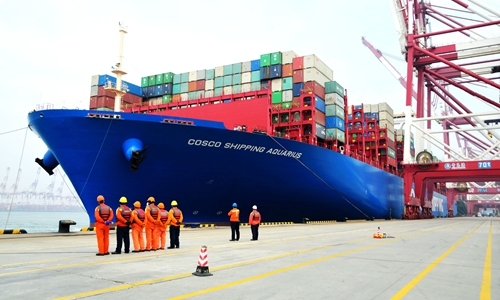HOME >> SOURCE
China’s trade with SK, Japan faces decline
By Zhang Dan Source:Global Times Published: 2020/2/26 21:42:30
Chinese ports grapple with plunging shipments amid epidemic

A COSCO ship at Qingdao Port in East China's Shandong Province on February 11 Photo: IC
Logistics enterprises at major ports in China foresee significant declines in export throughput this month due to weak domestic production and transport limits set by foreign countries. Further, surging confirmed cases of COVID-19 in South Korea and Japan may make the situation worse, leading to severe global supply chain disruptions, trade experts warned.
Given the cluster of coronavirus cases emerging in South Korea, China may feel the impact soon as the two countries produce mechanical parts the other one needs badly, Bai Ming, deputy director of the Ministry of Commerce's International Market Research Institute, told the Global Times on Tuesday.
"The virus outbreak is hurting China, South Korea and Japan, and the world will feel the pain," Bai noted, adding there will be "significant drops in February's trade between China and South Korea as well as between China and Japan."
It will require half a year for China's shipping enterprises to fully recover as the pressure of competition and difficulties in operation, capital and labor pile up, Wu Minghua, a veteran transport industry analyst, told the Global Times.
"At least 129 countries and regions have set additional entry checks for Chinese nationals and some of them put restrictive measures on Chinese ships - once a ship bearing Chinese goods enters the port, it must drop anchor and float for 14 days as a quarantine period," Wu said, noting it costs 600,000 yuan ($85,242) for 10,000 containers floating near port per day, and such loss made some ships skip the ports which give restrictive measures on Chinese goods.
Orders plunge
Export orders plunged at least half in February compared with the same period last year for Qingdao Qianwan Container Terminal Co, according to an employee surnamed Xie.
Xie said overall, recent imports have not decreased as large volumes of frozen pork, fodder and cotton have been transported to the port.
Qingdao Port in East China's Shandong Province is known for its large cargo handling capacity. Its throughput surpassed 600 million tons by the end of 2019, the Xinhua News Agency said. From the port, it takes 21 hours to reach Inchon and 28 hours to Busan, South Korea.
As of Tuesday, the usage rate of refrigerated container sites in Qingdao Port was only 38.72 percent, the company said on its website.
Although the port has waived companies' container storage charges from January 24 to February 9, according to Xie, logistics companies have to deal with the loss of orders for a while until there is a full recovery of factory operations across China.
Qingdao is not the only port to report an export decline.
"It is for sure that Tianjin Port's throughput of foreign trade will drop," a staff member who spoke anonymously at Tianjin-based Yicheng Logistics told the Global Times.
Due to the halt of some foreign flights to China, clients cannot come to see the products in person, hence, they have postponed orders, she said, noting that "many overseas orders are being postponed or cancelled, because various goods are in short supply."
The novel coronavirus outbreak has brought most of China's factories to a standstill, with part of them resuming production gradually.
Across China, one of the world's manufacturing hubs, about 30 percent of small and medium-sized enterprises had resumed work as of Tuesday, according to the Ministry of Industry and Information Technology.
Wuhan, the epicenter of the epidemic, has not stopped shipments. In addition, Wuhan Yangluo Port undertakes great responsibility when transporting medical supplies as land and air transportation are both disrupted.
She Qi, an employee in the order acceptance department at Wuhan Port Container Co, told the Global Times his team used to receive 300 to 400 orders per day; by contrast, he has only received fewer than 100 orders per day so far this year.
More importantly, "none of them were export orders on Tuesday," he noted.
Sitting in the midstream of the Yangtze River basin, the location gives Wuhan convenience to send exports to major ports in Shanghai and Chongqing. Wuhan Yangluo Port can export shipments to South Korea, Japan and Southeast Asia.
Trade in danger
From January 27, the two scheduled passenger-cargo liners services from Shanghai to Japan were halted and had not fully recovered as of Tuesday because Japan's epidemic situation has become worrisome in recent days, Wu told the Global Times.
The number of Chinese export shipments has kept decreasing, he noted.
The grim situation in South Korea would bring new shocks to the China-South Korea trade tie, which had encountered difficulty since January, said Zhao Jinping, former head of the foreign economic research department at the Development Research Center of the State Council.
South Korea mainly sells electronics, autos, mechanical parts and steel to China, which relies on China's exports to the global market and domestic investment growth, Zhao told the Global Times.
"Facing a difficult year for foreign trade and investment growth, China will slow its demand for these South Korean products," he said, noting the decline of South Korea's annual exports to China will be larger than that of the bilateral trade drop.
South Korea's exports to China fell 3.7 percent in the first 20 days of February from the same period last year, South Korea's official customs data showed on Friday.
Commenting on whether labor-intensive countries would benefit from a possible supply chain transfer from the three North Asian countries, Bai said there should be no concern.
"If factories in China, South Korea and Japan halted production, there would be fewer possibilities for other countries' supply chains to develop… because countries like Vietnam do not have the supporting facilities and machines, especially in high-end manufacturing," he noted.
RELATED ARTICLES:
Posted in: ECONOMY,BIZ FOCUS